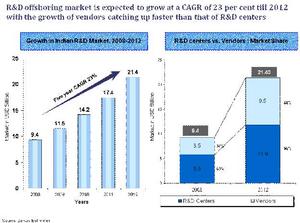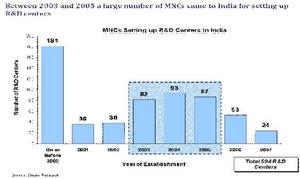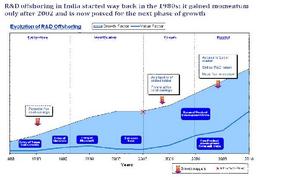SUNNYVALE, CA--(Marketwire - August 11, 2008) - Zinnov, a leading management consulting firm,
today released the results of its first annual study on the R&D landscape
in India. The report, entitled "Strategic Guide on Indian R&D Centers,
2008," reveals India as a top choice among multinational companies for
research and development across verticals, particularly in enterprise
software, telecommunications and networking. The study uncovers a larger
workforce of R&D talent than previously thought, and underscores the
country's reputation as an affordable location to establish and operate R&D
centers.
The study reveals that, multinational corporations still find immense value
in establishing offshore R&D centers in India, as illustrated by a
remarkable leap from 180 centers in 2000 to nearly 600 in 2008. The report
also projects that the R&D offshoring market will grow from its current
share of $9.35 billion to over $21 billion by 2012, representing a CAGR of
23 percent over that period (see Figure 1). Majority of this growth will be
driven by large R&D centers of these multinationals and by service
providers.
The report indicates that this trend towards offshoring of R&D is primarily
driven by an increase in the available talent pool in India over the last
five years. However, Zinnov believes that cost savings will also continue
to be a driving factor for these multinationals to show interest in
offshoring product development to India. While recent industry reports have
indicated that the cost of doing business in India is rising, it is still
comparatively less expensive than that in the United States. In fact, the
report highlights that the cost per employee has grown at a rate of about
16.2 percent between 2005 and 2007. However, this growth rate is expected
to become a little sluggish with the controlled increase in compensation
levels and stability in real estate prices.
India's Growing Talent Pool
While cost savings drove the first wave of offshoring to India in the 1980s
and 1990s, the report states that it was between 2003 and 2005 that
multinationals started leveraging India for its large talent pool base and
growing local market. (see Figure 2 and Figure 3).
Zinnov's research indicates that approximately 250,000 engineers currently
work in India's R&D ecosystem of which about 140,000 work for R&D centers
of multinationals and the rest with service providers. With a huge number
like 140,000 engineers working in R&D centers, Bangalore has the world's
second largest R&D talent pool (Silicon Valley has the largest).
Reasons for Increase in India's Talent Pool
Until five years back, multinationals used to primarily offshore work
related to product testing and other low complexity aspects of product
development to India. In many cases, India centers were treated as extended
teams of their main centers in the U.S. and Europe. However, now with the
local Indian talent maturing, multinational companies are giving complete
ownership to their India centers to develop and deliver their products.
And, while the average full product ownership in the India R&D centers is
around 10 percent today, this number is projected to increase to 30 percent
by 2012. The various factors that account for this trend include the
following:
-- The introduction of new technologies over the past five years -- such
as SaaS, SOA, open source and Cloud Computing -- has created a level
playing field for Indian developers.
-- Returning expatriates: The report showcases that 30,000 Indian
expatriates have returned to India in the recent years after working in
product companies in the U.S. These individuals have rich experience in
designing and delivering products.
-- The number of graduates from IIT and other top Indian universities
relocating to the United States has been declining in India as new and
exciting opportunities are available within the country itself. This trend
is expected to have a significant impact on the industry in the next five
to 10 years on the industry.
Looking forward
Product management and architect skills, specifically, are hard to find in
India at the moment. However, the number of Indian-based workers with these
skills is expected to increase in the next three to five years due to the
increasing experience in the existing R&D teams as well the number of
expatriates returning to India. This situation is expected to further fuel
the product development/innovation capabilities in India.
Methodology
Data in Zinnov's "Strategic Guide on Indian R&D Centers, 2008" were
compiled from primary and secondary research from India's 594 captive
centers. Research was derived from a combination of questionnaires and
interviews with the senior managers/country heads of over 300 of the
centers and a sampling analysis of all 594 during the November 2007 to
March 2008 period. The respondents, located across major cities in India as
well as their U.S. counterparts, were queried on best practices, cost
details, governance, transition road maps, project types and models,
innovation capability at the India centers, and the outlook for all these
parameters.
About Zinnov LLC
Founded in 2002, Zinnov -- meaning Zeal in innovation -- is a leading
management consulting company providing services in the area of Offshore
Advisory, Market Expansion and Human Capital Optimization to Fortune 1000
companies. They work collectively with clients to tackle prevailing
organizational challenges by analyzing the changing dynamics, improving
performance, and building institutional capability. The services delivered
to their clients through advanced reasoning and analytical techniques,
provides solutions that help in integrating organizational vision, business
definition & processes.
Contact Information: For more information, contact:
Kinjal Chhetri
Zinnov LLC
Email:
Ph: +1-408-716-8432
Michael Lindenberger
BOCA Communications
Ph:+1-415-531-1449


